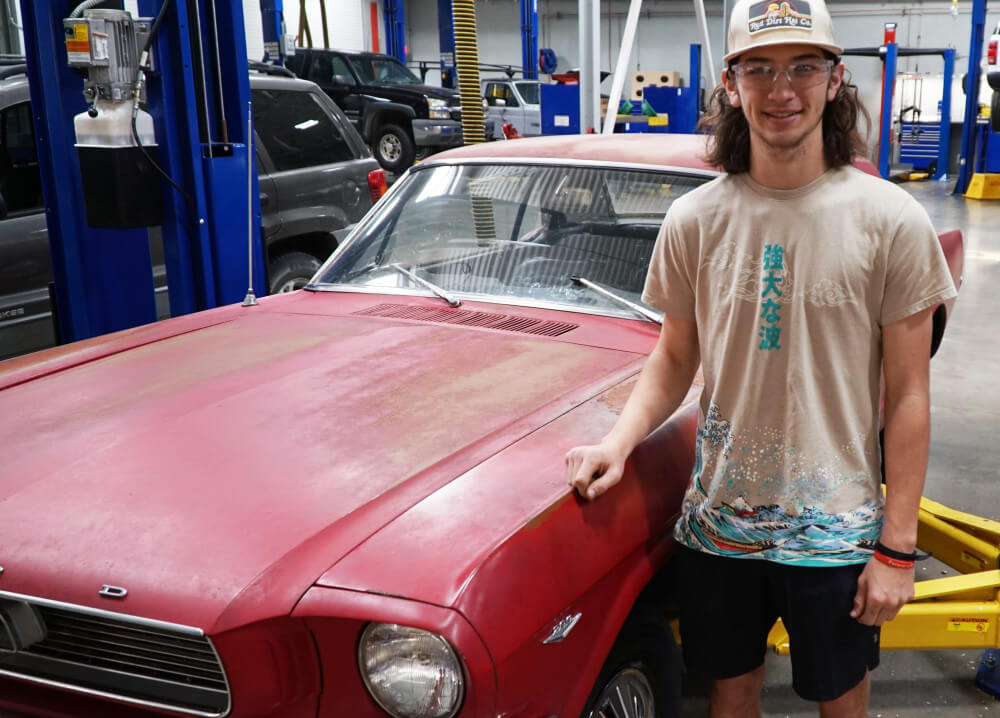Ford Motors made a splash at the 1964 World’s Fair in New York City with the unveiling of a “new line of cars.” The Mustang was billed as a total performance vehicle at a modest price.
A new two-door hardtop or convertible with bucket seats could be had for as little as $2,368 or significantly more with the largest list of options and accessories ever offered on a car.
Mustang production began in March 1964. What ensued was a love affair by the car-buying American public that has spanned nearly six decades. The first Mustang was a 1965 model, later rebranded as a 1964 ½ model.
Little changed as the 1966 models rolled out in part because Ford was selling them so quickly. In fact, the ’66 Mustang remains Ford’s top-selling Mustang of all time with more than 607,000 cars sold.
A.J. Smith, 17, of Yukon, owns a 1966 Mustang. Smith has a penchant for cars that has been satisfied by enrolling in Automotive Service Technology at Canadian Valley Technology Center’s El Reno Campus. He wants to own an auto repair shop one day.
Smith is the fourth generation of his family to own this Ford Mustang. The car formerly belonged to his parents, Bill and Mariah, both of Yukon. A.J. Smith’s grandmother, Ruth, and his father learned to drive in this car.
Robert Liebst, A.J.’s great-grandfather, purchased the now iconic car off a showroom floor in Kansas City. Sticker price had increased to $2,416 for the basic coupe. The optional convertible model cost an extra $236 at the time.
Liebst chose the hardtop, small block V8 289 cubic-inch engine. It yielded 200 horsepower and featured a 2-barrel carburetor. He bought the car for his wife so she could re-enter the workforce in a reliable car.
The Signal Flare Red paint has oxidized over time, and the car needed some TLC. Smith said his dad restored the car after inheriting it in 1993.
“It has been sitting since 1998,” A.J. Smith said.
To be fair, Bill Smith said he stopped driving the Mustang when he started driving a Chevy S-10 pickup – because the mileage was better. Ouch! An auto icon was shelved for a truck.
The 1966 Mustang fetched little more than 12 mpg in fuel economy. The car was marketed as going from 0 to 60 mph in 8.3 seconds with a listed max speed of 92 mph.
As the Mustang was being developed, then-Ford vice president and general manager Lee Iacocca said the company envisioned a sporty youth-market car based on the compact Falcon.
Mustang’s overwhelming popularity forced the company to produce cars at three factory locations to keep up with demand. That demand has since waned, at least for showroom-new Mustangs. Ford sales data shows just over 44,000 cars were moved last year, the eighth straight year of declining sales. The Mustang surpassed 100,000 cars sold only twice in the past 15 years.
A.J. Smith, a junior at Yukon High School, said he got his car running, but the water pump and several hoses were shot. So, the car is back in the shop at CV Tech. He is replacing those and adding a new timing gear chain. Soon, he will be cruising Garth Brooks Boulevard in “classic” fashion once again.
“I’m very excited being able to drive it,” he said. “I’ve been around it my whole life. Since I was very young, I wanted to drive it.”

